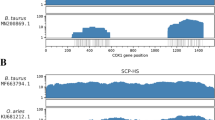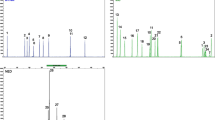Abstract
One of the major risks in cell culture laboratories is the misidentification and cross-contamination of cell lines. Several methods have been used to authenticate cell lines, including isoenzyme profiling, the test suggested by European Farmacopeia, which is performed at the Tissue Culture Centre in Brescia. However, this method displays several disadvantages, such as high variability and low reproducibility, and it is time consuming and requires high cell concentrations to be performed. Therefore, an alternative method has been developed to confirm the specie of origin of 27 different animal cell cultures. A polymerase chain reaction (PCR)–restriction fragment length polymorphism (RFLP) assay was optimized, based on the use of a pair of primers that anneal to a portion of the cytochrome b gene in all the species. The amplification product was digested with a panel of six restriction enzymes, and the pattern derived was resolved on 3% high-resolution agarose gel. For 23 species, this protocol produced a unique restriction pattern, and the origin of these animal cells resulted to be confirmed by this analysis. Furthermore, results indicate that cytochrome b PCR-RFLP was able to amplify target sequences using very low amounts of deoxyribonucleic acid (DNA). Its sensitivity in detecting interspecies, cross-contamination was comparable to that of isoenzyme analysis (contaminating DNA should represent at least 10% of the total DNA). For 4 of the 27 species (sheep, dog, Guinea pig, and Rhesus monkey) the observed pattern, even if highly reproducible, showed additional bands; for these species, specific PCR was also performed.





Similar content being viewed by others
References
Bellagamba F.; Moretti V. M.; Comincini S.; Valfrè F. Identification of species in animal feedstuffs by polymerase chain reaction—restriction fragment length polymorphism analysis of mitochondrial DNA. J. Agric. Food Chem. 498: 3775–3781; 2001.
Bottero M. T.; Dalmasso I. A.; Nucera D.; Turi R. M.; Rosati S.; Squadrone S.; Goria M.; Civera T. Development of a PCR assay for the detection of animal tissues in ruminant feeds. J. Food Prot 6612: 2307–2312; 2003.
Bravi C. M.; Lirόn J. P.; Mirol P. M.; Ripoli M. V.; Peral-Garcia P.; Giovambattista G. A simple method for domestic animal identification in Argentina using PCR-RFLP analysis of cytochrome b gene. Leg. Med. (Tokyo) 64: 246–251; 2004.
Cooper J. K.; Sykes G.; King S.; Cottrill K.; Ivanova N. V.; Hanner R.; Ikonomi P. Species identification in cell culture: a two-pronged molecular approach. In Vitro Cell Dev. Biol.—Anim. 43: 344–351; 2007.
Coupe S.; Sarfati C.; Hamane S.; Derouin F. Detection of cryptosporidium and identification to the species level by nested PCR and restriction fragment length polymorphism. J. Clin. Microbiol. 433: 1017–1023; 2005.
Dalmasso A.; Fontanella E.; Piatti P.; Civera T.; Rosati S.; Bottero M. T. A multiplex PCR assay for the identification of animal species in feedstuffs. Mol. Cell. Probes 182: 81–87; 2004.
Dirks W.; MacLeod R. A.; Jäger K.; Milch H.; Drexler H. G. First searchable database for DNA profiles of human cell lines: sequential use of fingerprint techniques for authentication. Cell. Mol. Biol. 456: 841–853; 1999.
Gao H. W.; Liang C. Z.; Zhang Y. B.; Zhu L. H. Polymerase chain reaction method to detect canis materials by amplification of species-specific DNA fragment. J. AOAC Int. 875: 1195–1199; 2004.
Ha J. C.; Jung W. T.; Nam Y. S.; Moon T. W. PCR identification of ruminant tissue in raw and heat-treated meat meals. J. Food Prot. 699: 2241–2247; 2006.
Hebert P. D.; Stoeckle M. Y.; Zemlak T. S.; Francis C. M. Identification of birds through DNA barcodes. PloS Biol. 210: e312; 2004.
Lanzilao I.; Burgalassi F.; Fancelli S.; Settimelli M.; Fani R. Polymerase chain reaction–restriction fragment length polymorphism analysis of mitochondrial cytb gene from species of dairy interest. J. AOAC Int. 881: 128–135; 2005.
Li Q. Q.; Zhang Y. P. Phylogenetic relationships of the macaques (Cercopithecidae: Macaca), inferred from mitochondrial DNA sequences. Biochem. Genet. 437–8: 375–386; 2005.
Martellini A.; Payment P.; Villemur R. Use of eukaryotic mitochondrial DNA to differentiate human, bovine, porcine and ovine sources in fecally contaminated surface water. Water Res. 394: 541–548; 2005.
Matsuda H.; Seo Y.; Kakizaki E.; Kozawa S.; Muraoka E.; Yukawa N. Identification of DNA of human origin based on amplification of human-specific mitochondrial cytochrome b region. Forensic Sci. Int. 1522–3: 109–114; 2005.
Meyer R.; Höfelein C.; Lüthy J.; Candrian U. Polymerase chain reaction-restriction fragment length polymorphism analysis: a simple method for species identification in food. J. AOAC Int. 786: 1542–1551; 1995.
Milanesi E.; Ajmone-Marsan P.; Bignotti E.; Losio M. N.; Bernardi J.; Chegdani F.; Soncini M.; Ferrari M. Molecular detection of cell line cross-contaminations using amplified fragment length polymorphism DNA fingerprinting technology. In Vitro Cell. Dev. Biol. Anim. 393–4: 124–130; 2003.
Mueller U. G.; Wolfenbarger L. L. AFLP genotyping and fingerprinting. Trends Ecol. Evol. 1410: 389–394; 1999.
Murray B. W.; McClymont R. A.; Strobeck C. Forensic identification of ungulate species using restriction digests of PCR-amplified mitochondrial DNA. J. Forensic Sci. 406: 943–951; 1995.
Myers M. J.; Farrell D. E.; Heller D. N.; Yancy H. F. Development of a polymerase chain reaction-based method to identify species-specific components in dog food. Am. J. Vet. Res. 651: 99–103; 2004.
Nelson-Rees W. A.; Daniels D. W.; Flandermeyer R. R. Cross-contamination of cells in culture. Science 2124493: 446–452; 1981.
Nims R. W.; Shoemaker A. P.; Bauernschub M. A.; Rec L. J.; Harbell J. W. Sensitivity of isoenzyme analysis for the detection of interspecies cell line cross-contamination. In Vitro Cell Dev. Biol.—Anim. 341: 35–39; 1998.
O’Brien S. J.; Simonson J. M.; Grabowski M. W.; Barile M. F. Analysis of multiple isoenzyme expression among twenty-two species of Mycoplasma and Acholeplasma. J. Bacteriol. 1461: 222–232; 1981.
Ono K.; Satoh M.; Yoshida T.; Ozawa Y.; Kohara A.; Takeuchi M.; Mizusawa H.; Sawada H. Species identification of animal cells by nested PCR targeted to mitochondrial DNA. In Vitro Cell Dev. Biol.—Anim. 43: 168–175; 2007.
Parodi B.; Aresu O.; Bini D.; Lorenzini R.; Schena F.; Visconti P.; Cesaro M.; Ferrera D.; Andreotti V.; Ruzzon T. Species identification and confirmation of human and animal cell lines: a PCR-based method. Biotechniques 322: 432–434, 436, 438–440; 2002.
Steube K. G.; Grunicke D.; Drexler H. G. Isoenzyme analysis as a rapid method for the examination of the species identity of cell cultures. In Vitro Cell Dev. Biol.—Anim. 312: 115–119; 1995.
Steube K. G.; Meyer C.; Uphoff C. C.; Drexler H. G. A simple method using beta-globin polymerase chain reaction for the species identification of animal cell lines—a progress report. In Vitro Cell Dev. Biol.—Anim. 3910: 468–475; 2003.
Zehner R.; Zimmermann S.; Mebs D. RFLP and sequence analysis of the cytochrome b gene of selected animals and man: methodology and forensic application. Int. J. Legal Med. 1116: 323–327; 1998.
Acknowledgments
We would like to thank Mrs. Anna Mor, Mrs. Annalisa Ghizzardi, Mrs. Roberta Trainini, and Mrs. Eleonora Bradanini for their technical assistance. This work was supported by the Italian Ministry of Health.
Author information
Authors and Affiliations
Corresponding author
Additional information
Editor: J. Denry Sato
Rights and permissions
About this article
Cite this article
Losi, C.G., Ferrari, S., Sossi, E. et al. An alternative method to isoenzyme profile for cell line identification and interspecies cross-contaminations: cytochrome b PCR-RLFP analysis. In Vitro Cell.Dev.Biol.-Animal 44, 321–329 (2008). https://doi.org/10.1007/s11626-008-9125-x
Received:
Accepted:
Published:
Issue Date:
DOI: https://doi.org/10.1007/s11626-008-9125-x




